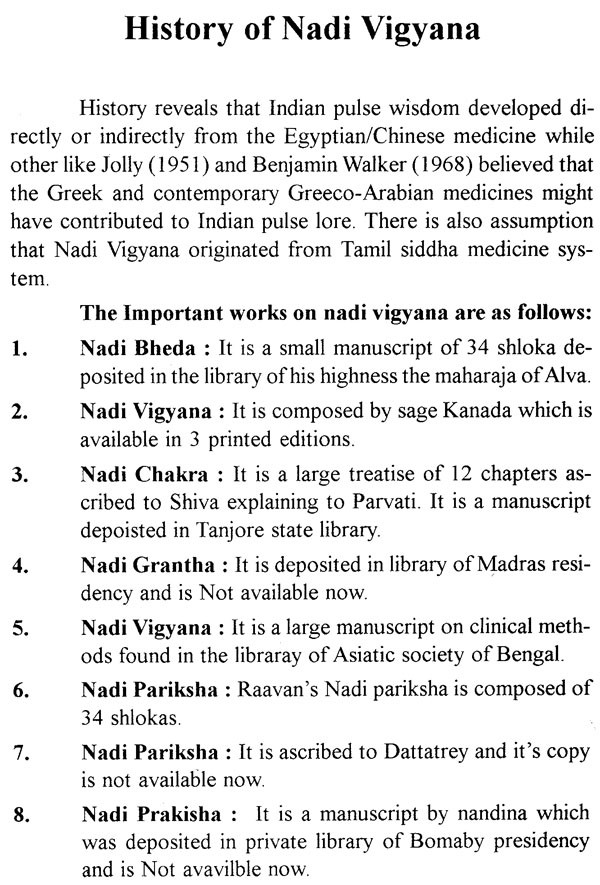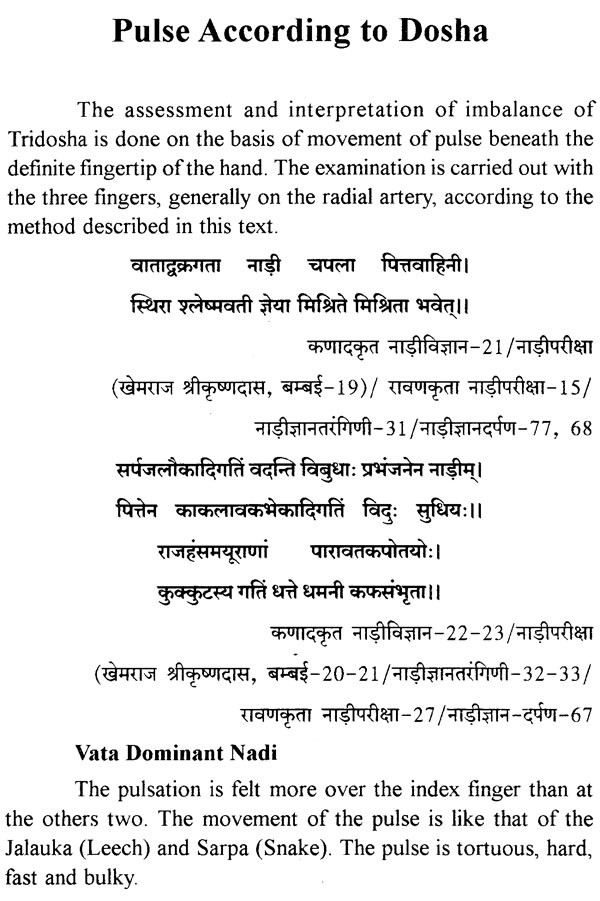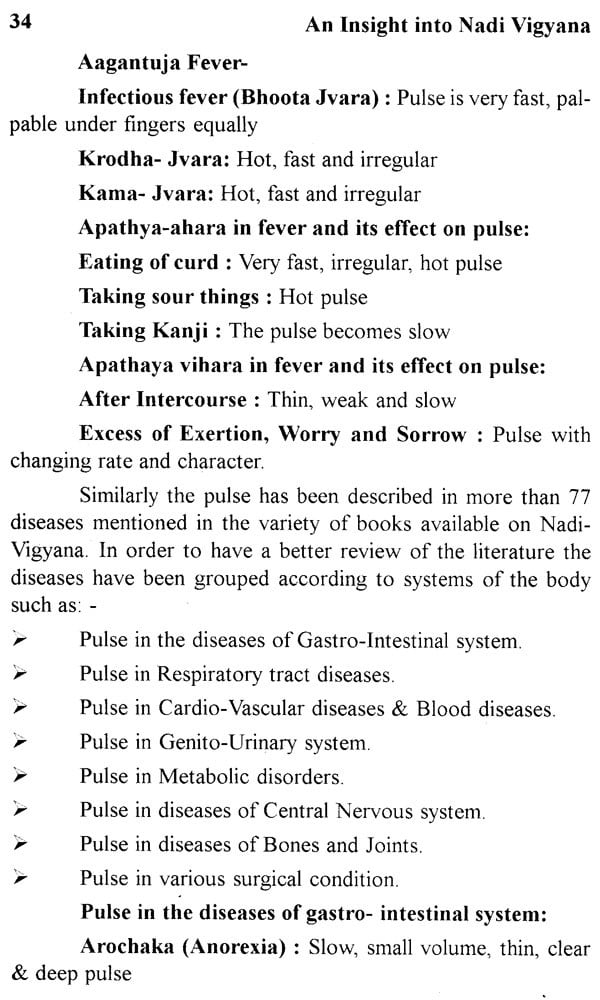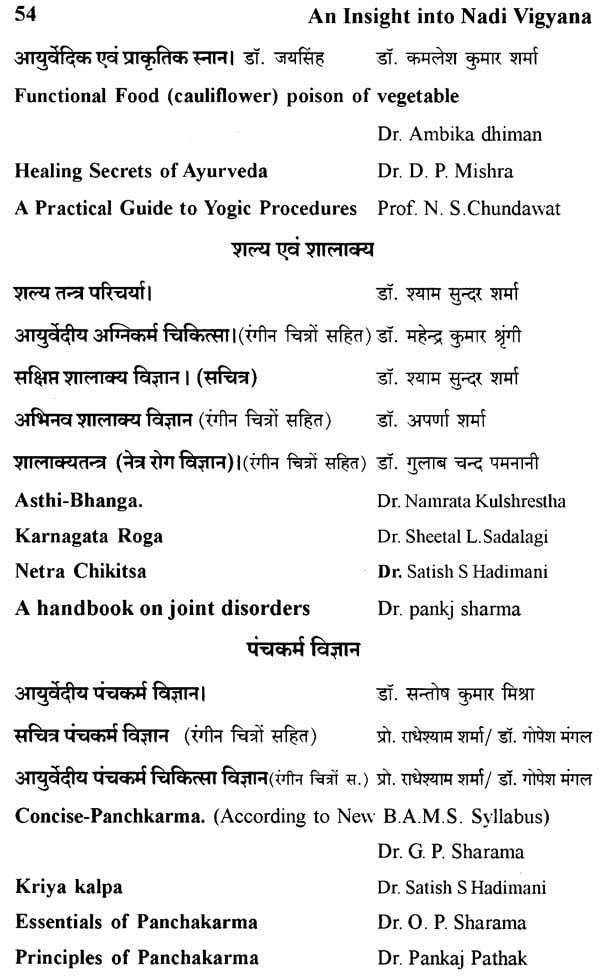From time immemorial, examination of pulse has been one of the most significant diagnostic techniques. The art and science of pulse examination was well developed in ancient In-dia. Eminent Ayurvedic physicians gave treatment by examina-tion of pulse alone. They had recognized the pulse as the most essential sign of life and paid great attention to the character of pulse in health and disease. Sharangdhara was very specific when he quoted: 3ilit31171Tril TIT trir41 ,dt41 /34 .sui tir 0)1to-ti trfatra:H That is the place where life resides is dhamani which is a synonym of Nadi. It is very limited but has very significant role in diagno-sis. In examination of patients Nadi is mentioned at first place. Even in this era of advanced technology, the pulse examination is admired by the people worldwide. The patients who visit Ayurvedic physicians for treatment are still inclined to be diag-nosed by Nadi- Pareeksha. Innumerable intellects have contributed in the advance-ment & development of the system of medicine. In the medieval period, the `Ashtasthana Pareeksha' became was very well-liked which included the inspection, observation and examination of Nadi, Mala, Mutra, Jihva, etc. This Ashtasthana Pareeksha' was more popular in the southern part of the country. However, the Nadi-Pareeksha was an important and the invariable part of the patient's examination in Northern India also and even today the Nadi-Pareeksha is in practice among the old generations of
About the Authors Dr. (Mrs.) Pankaj Sharma is an Ayurveda doctorate in Kaya Chikitsa from National Institute of Ayurveda, Jaipur. She completed her post graduation in Kaya Chikitsa from Rajiv Gandhi Post Graduate Research Institute of Ayurveda, Paprola, Himachal Pradesh. She completed her graduation from Sri Krishna Government Ayurveda College and Hospital, Kurukshetra, Haryana. She has delivered many talks regarding Ayurveda on Radio. She has presented many national and international papers and her publications include many articles in peer reviewed national and international journals. Presently she is associated with teaching undergraduates of Ayurveda and Diploma Pharmacy (Ayurveda) students at Government Ayurvedic College, Patiala, Punjab.
Dr. Vikas Bhardwaj is an Ayurveda post graduate in Basic Principles from Sri Dharmasthala Manjunatheshwara Ayurveda College and Hospital, Hassan, Karnataka. He completed his graduation from Sri Krishna Government Ayurveda College and Hospital, Kurukshetra, Haryana. He has presented national and international papers and was awarded with Best paper presentation in national Seminar on Basic principles at Hubli, Karnataka. He has published many articles in peer reviewed national and international journals. Presently he is associated with teaching undergraduates of Ayurveda in an Ayurvedic College in Punjab.
Preface The aim of Ayurveda is to preserve the health of Swastha person and cure the ailing individual. For treating the ailing person, the physician has to examine thoroughly the patient. The methods of examining are widely explained in Ayurveda. One of the components of that examination protocol is Nadi assessment. Of late the Ayurvedic physicians have not been able to cope with the knowledge acquired by their ancestors regarding the examination of Nadi/Pulse. According to intellects Nadi examination provides a varied information regarding the state of Doshas, diet, Physical and mental well being of an individual.
Ayurveda, the science of life, is one of the most primordial health knowledge and gives importance to diagnosis first and then plan a treatment. The science opines if a Physician is able to diagnose properly the diseases, he is sure to get success in treating his patient. For diagnosing properly the Physician needs to examine Nadi also as stated by our Samhitas.
Assessment of Nadi is one of the diminishing arts practiced by our sages. Current book deals with enumeration of some of the facts regarding the Nadi. Reading of this book will infuse interest and create awareness among Ayurvedic fraternity towards importance of Nadi Vigyana. While composing this book we were glad to know about various references ofNadi Pareeksha in our ancient literature and the mention of which will definitely help scholars of Ayurveda who are interested in learning this valuable skill.
Introduction From time immemorial, examination of pulse has been one of the most significant diagnostic techniques. The art and science of pulse examination was well developed in ancient In-dia. Eminent Ayurvedic physicians gave treatment by examination of pulse alone. They had recognized the pulse as the most essential sign of life and paid great attention to the character of pulse in health and disease.
Sharangadhara was very specific when he quoted:
That is the place where life resides is dharmami which is a synonym of Nadi.
It is very limited but has very significant role in diagnosis. In examination of patients Nadi is mentioned at first place. Even in this era of advanced technology, the pulse examination is admired by the people worldwide. The patients who visit Ayurvedic physicians for treatment are still inclined to be diagnosed by Nadi- Pareeksha.
Innumerable intellects have contributed in the advance-ment & development of the system of medicine. In the medieval period, the `Ashtasthana Pareeksha' became was very well-liked which included the inspection, observation and examination of Nadi, Mala, Mutra, Jihva, etc. This Ashtasthana Pareeksha' was more popular in the southern part of the country.
Book's Contents and Sample Pages
















